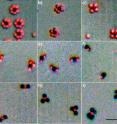Creating nano-structures from the bottom up
Microscopic particles are being coaxed by Duke University engineers to assemble themselves into larger crystalline structures by the use of varying concentrations of microscopic particles and magnetic fields. These nano-scale crystal structures, which until now have been difficult and time-consuming to produce using current technologies, could be used as basic components for advanced optics, data storage and bioengineering, said the research team.
"Not only did we develop the theoretical underpinning for this new technique, but we demonstrated in the lab that we could create more than 20 different programmed structures," said Benjamin Yellen, assistant professor of mechanical engineering and materials science at Duke's Pratt School of Engineering and lead member of the research team. The results of the Duke experiments were published online in the journal Nature Communications.
"Despite the promise of creating new classes of human-made structures, current methods for creating these tiny structures in a reliable and cost-effective way remains a daunting challenge," Yellen said. "This new approach could open pathways for fabricating complex materials that cannot be produced by current techniques."
The traditional method for creating human-made crystals is described as "top-down" by Yellen, which means they are fashioned by lithography or molding techniques, and can't be easily created in three dimensions.
"Our approach is much more 'bottom up,' in that we're starting at the level of a model 'atom' and working our way up," Yellen said.
By manipulating the magnetization within a liquid solution, the Duke researchers coaxed magnetic and non-magnetic particles to form intricate nano-structures, such as chains, rings and lattices.
The nano-structures are formed inside a liquid known as a ferrofluid, which is a solution consisting of suspensions of nanoparticles composed of iron-containing compounds. One of the unique properties of these fluids is that they become highly magnetized in the presence of external magnetic fields. The particles that are less magnetic than the ferrofluid behave similarly to negative charges, whereas the particles that are more magnetic than the ferrofluid act like positive charges. The opposite particles thus attract one another to form structures resembling salt crystals.
Since the magnetization of the fluid and the concentrations of the particles controls how the particles are attracted to or repelled by each other, the researchers were able to control the shapes and patterns of assembly. By appropriately "tuning" these interactions, the magnetic and non-magnetic particles form around each other much like a snowflake forms around a microscopic dust particle.
According to Yellen, researchers have long been able to create tiny structures made up of a single particle type, but the demonstration of sophisticated structures assembling in solutions containing multiple types of particles has been difficult to achieve. The structure of these nano-structures determines how they can ultimately be used.
Yellen foresees the use of these nano-structures in advanced optical devices, such as sensors, where different nano-structures could be designed to possess custom-made optical properties. Yellen also envisions that rings composed of metal particles could be used for antenna designs, and perhaps as one of the key components in the construction of materials that display artificial "optical magnetism" and negative magnetic permeability.
Other members of the team Duke's Karim Khalil, Amanda Sagategui, Mukarram Tahir, Joshua Socolar and Benjamin Wiley.
The research was supported by the Research Triangle Materials Research Science and Engineering Center, which is funded by the National Science Foundation.
Source: Duke University
Other sources
- Creating Nano-Structures from the Bottom Upfrom Science BlogWed, 25 Apr 2012, 13:01:15 UTC
- Creating nano-structures from the bottom upfrom Science DailyTue, 24 Apr 2012, 18:20:36 UTC
- Creating nanostructures from the bottom upfrom PhysorgTue, 24 Apr 2012, 15:50:14 UTC
